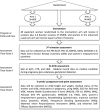Cognitive-behavioral therapy-based intervention to treat symptoms of anxiety in pregnancy in a prenatal clinic using non-specialist providers in Pakistan: design of a randomised trial
- PMID: 32300002
- PMCID: PMC7200036
- DOI: 10.1136/bmjopen-2020-037590
Cognitive-behavioral therapy-based intervention to treat symptoms of anxiety in pregnancy in a prenatal clinic using non-specialist providers in Pakistan: design of a randomised trial
Abstract
Introduction: Prenatal anxiety is a prevalent condition that is harmful for women and a strong predictor of postpartum depression. This trial assesses an intervention initiated in early pregnancy to mid pregnancy among women with clinical or subclinical symptoms of anxiety in Pakistan. METHODS AND ANALYSIS: Happy Mother, Healthy Baby (HMHB) is a phase three, two-arm, single-blind, individual randomised clinical trial conducted in the outpatient department of Holy Family Hospital, a large public tertiary care facility affiliated with Rawalpindi Medical University (RMU). Pregnant women (enrolled at ≤22 weeks of gestation) receive six individual HMHB sessions based on cognitive-behavioral therapy (CBT) and relaxation techniques that are administered by non-specialist providers and tailored to address anxiety symptoms. Two to six booster sessions are given between the fifth consecutive weekly core session and the sixth core session that occurs in the third trimester. Apart from baseline data, data are collected in the third trimester, at birth and at 6-weeks postpartum. Primary outcomes include diagnoses of postpartum common mental disorders. Secondary outcomes include symptoms of anxiety and of depression, and birth outcomes including small-for-gestational age, low birth weight and preterm birth. An economic analysis will determine the cost effectiveness of the intervention.
Ethics: Ethics approval was obtained from the Johns Hopkins Bloomberg School of Health Institutional Review Board (Baltimore, USA), the Human Development Research Foundation Ethics Committee (Islamabad, Pakistan), the RMU Institutional Research Forum (Rawalpindi, Pakistan) and the National Institute of Mental Health-appointed Global Mental Health Data Safety and Monitoring Board.
Dissemination: Results from this trial will build evidence for the efficacy of a CBT-based intervention for pregnant women delivered by non-specialised providers. Identification of an evidence-based intervention for anxiety starting in early pregnancy to mid pregnancy may be transferable for use and scale-up in other low-income and middle-income countries.
Trial registration number: NCT03880032.
Keywords: anxiety disorders; depression & mood disorders; prenatal diagnosis; therapeutics.
© Author(s) (or their employer(s)) 2020. Re-use permitted under CC BY-NC. No commercial re-use. See rights and permissions. Published by BMJ.
Conflict of interest statement
Competing interests: None declared.
Figures



References
-
- Wachs TD, Black MM, Engle PL. Maternal depression: a global threat to children’s health, development, and behavior and to human rights. Child Dev Perspect 2009;3:51–9. 10.1111/j.1750-8606.2008.00077.x - DOI
-
- Niaz S, Izhar N, Bhatti MR. Anxiety and depression in pregnant women presenting in the OPD of a teaching hospital. Pak J Med Sci 2004;20:117–9.
